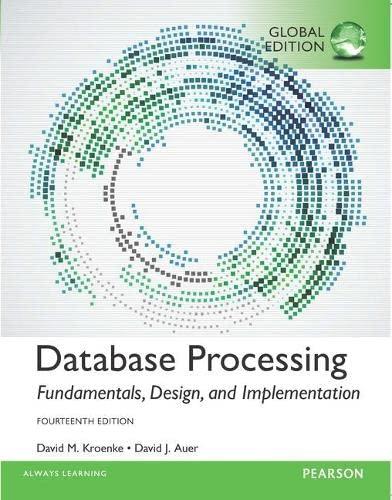Question
All Questions are based on the following case study. Case study: You are required to develop an application to detect plagiarism in submitted assessment-related work.
All Questions are based on the following case study.
Case study:
You are required to develop an application to detect plagiarism in submitted assessment-related work. The main task of the system is to identify whether a given submission has similarities with other submissions. It is expected that the system will be able to identify the source (of similarity) and also measure the percentage of similarity. Traditional plagiarism detection systems work on text documents. The system you will develop will need to work with a wide variety of content, currently including text documents, images, videos, audio clips, as well as source code is written in a variety of languages. It should be possible to add new types of submissions in the future. Each submission can have content of more than one of these types. The system will currently have three types of users. The administrators are superusers and have access of all the functionality of the system. They can also assume the alias of other existing users and perform actions as the aliased user. However, in such situations, the system must record that the action was not done by the actual user, but by an administrator assuming the alias. Administrators are also responsible for adding new users to the system and defining/changing their levels of access.
Some users can create assessment tasks. These could be created for many reasons, including projects, assignments, homeworks, classworks etc. Each assessment task can have a list of submitters. Submitters will submit content against such tasks. Tasks that do not have a list of submitters are open tasks, and any submitter can submit content against them. Each assessment task has a closing date+time. Once the closing time passes, no one can submit content against the task. The task creator can then log in to the system and trigger a plagiarism check. Plagiarism checks can be of two types: (a) that checks only within the submissions made against the task, (b) that checks the entire database of content including new submissions. Once the check is finished a report is generated and the task creator is sent an email with the notification. The task creator can log in at any time and view the report in summary or in detail. Detailed reports show information about each submission and the sources used in the submission. The summary report just lists all the submissions in a tabular format and shows the overall similarity percentage. The title of the task, the closing date+time, and the submitters list is given by the task creator when he/she is creating the assessment task.
Plagiarism: the practice of taking someone else's work or ideas and passing them off as one's own.
Questions:
Q1. Draw the use case diagram of the system. (10)
Q2. Identify and name the design patterns you will use to design the system. For each pattern, briefly mention the relevant part of the system design. You are being asked about design patterns, not architectural patterns, so choose the patterns carefully.
(10)
Q3. Draw a UML Sequence diagram for creating an assessment task.Your sequence diagram must be consistent with the class diagram drawn in your answer to question 2.
(10)
Q4. Write the code for the controller responsible for triggering a plagiarism check. Your code must be consistent with your answers for Questions 2.. In addition your code must clearly show the class, method name, parameters and workflow in order to be eligible for any marks.
Step by Step Solution
There are 3 Steps involved in it
Step: 1

Get Instant Access to Expert-Tailored Solutions
See step-by-step solutions with expert insights and AI powered tools for academic success
Step: 2

Step: 3

Ace Your Homework with AI
Get the answers you need in no time with our AI-driven, step-by-step assistance
Get Started


